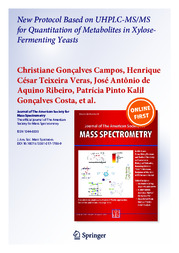New protocol based on UHPLC-MS/MS for quantitation of metabolites in xylose-fermenting yeasts.
New protocol based on UHPLC-MS/MS for quantitation of metabolites in xylose-fermenting yeasts.
Author(s): CAMPOS, C. G.; VERAS, H. C. T.; RIBEIRO, J. A. de A.; COSTA, P. P. K. G.; ARAÚJO, K. P.; RODRIGUES, C. M.; ALMEIDA, J. R. M. de; ABDELNUR, P. V.
Summary: Abstract: Xylose fermentation is a bottleneck in second-generation ethanol production. As such, a comprehensive understanding of xylose metabolism in naturally xylose-fermenting yeasts is essential for prospection and construction of recombinant yeast strains. The objective of the current study was to establish a reliable metabolomics protocol for quantification of key metabolites of xylose catabolism pathways in yeast, and to apply this protocol to Spathaspora arborariae. Ultra-high performance liquid chromatography coupled to tandem mass spectrometry (UHPLC-MS/MS) was used to quantify metabolites, and afterwards, sample preparation was optimized to examine yeast intracellular metabolites. S. arborariae was cultivated using xylose as a carbon source under aerobic and oxygen-limited conditions. Ion pair chromatography (IPC) and hydrophilic interaction liquid chromatography-tandem mass spectrometry (HILIC-MS/MS) were shown to efficiently quantify 14 and 5 metabolites, respectively, in a more rapid chromatographic protocol than previously described. Thirteen and eleven metabolites were quantified in S. arborariae under aerobic and oxygen-limited conditions, respectively. This targeted metabolomics protocol is shown here to quantify a total of 19 metabolites, including sugars, phosphates, coenzymes, monosaccharides, and alcohols, from xylose catabolism pathways (glycolysis, pentose phosphate pathway, and tricarboxylic acid cycle) in yeast. Furthermore, to our knowledge, this is the first time that intracellular metabolites have been quantified in S. arborariae after xylose consumption. The results indicated that fine control of oxygen levels during fermentation is necessary to optimize ethanol production by S. arborariae. The protocol presented here may be applied to other yeast species and could support yeast genetic engineering to improve second generation ethanol production. Graphical Abstract ?.
Publication year: 2017
Types of publication: Journal article
Unit: Embrapa Agroenergy
Observation
Some of Embrapa's publications are published as ePub files. To read them, use or download one of the following free software options to your computer or mobile device. Android: Google Play Books; IOS: iBooks; Windows and Linux: Calibre.
Access other publications
Access the Agricultural Research Database (BDPA) to consult Embrapa's full library collection and records.
Visit Embrapa Bookstore to purchase books and other publications sold by Embrapa.

